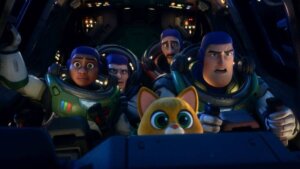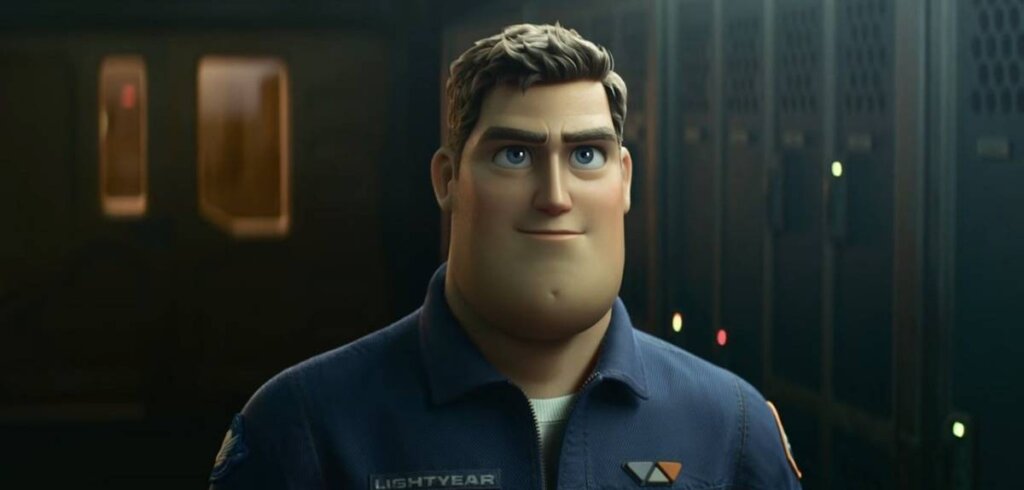Lightyear: The Taboo Breaking Movie from Pixar


Written and verified by the psychologist Valeria Sabater
After a two-year hiatus, Pixar has finally released its latest film, Lightyear, in a big way. However, this attempt has failed in part. That’s because several countries, most of them from the Middle East and some from the Asian sphere, have prohibited its screening. The reason? For showing a kiss between two women.
The apparently controversial scene, which was aimed at normalizing sexual diversity has demonstrated there’s still a long way to go before this can be achieved. Indeed, far from being residual, prejudice still has a significant presence in our society. It’s also present in many mental narratives that don’t see it as legal for an animated film to cross those barriers.
Pixar has long been committed to a clearly inclusive perspective as well as breaking down prejudices and taboos. Indeed, their productions frequently include other cultures and races. For example, Coco, Soul, Moana, Encanto, etc. That said, they hadn’t yet included the LGTBIQ community in any of their movies and considered it deserved a space in the world of animation.
Pixar seeks that its characters are increasingly inclusive and representative of the modern world.

Lightyear: a hero with an excess of self-confidence
While it’s true that the kiss scene has indisputable social relevance, it’s not the central theme of the latest production from the Pixar factory. Far from it. In fact, Lightyear has a direct relationship with Toy Story. As you probably remember, in this movie from 1995, we saw Andy, the child protagonist, receive the endearing action figure, Buzz Lightyear, as a gift.
Buzz Lightyear was the best friend of Sheriff Woody. He was also renowned for repeating the familiar phrase “To infinity and beyond!”. Apparently, Buzz was the toy that was manufactured as a result of a successful movie that Andy was fascinated by. Lightyear is that movie.
Thanks to its plot, Lightyear could almost be another Star Trek adventure. Instead, due to its aesthetics and design, it evokes the most beloved space opera of them all, none other than Star Wars. Indeed, it’s an intergalactic adventure that reminds the adult viewer of those great science-fiction productions of the 80s and 90s. Children, on the other hand, will be fascinated by other aspects of the movie.
A protagonist bent on correcting a mistake
Buzz Lightyear is a proud Star Force pilot. His mission is to take control of a ship with hundreds of people on board who are suspended in hypersleep. The aim is to take them to colonize various planets. He and his crew explore the galaxy looking for new worlds, just like Captain Kirk did with his Enterprise. Although Buzz calls his ship the turnip because of its similarity to this vegetable.
The truth is our protagonist is somewhat conceited, egotistical, and overly self-confident. In fact, he pilots the ship so recklessly that, at one point, he makes a bad maneuver and they end up stranded on an unwelcoming planet. He’s suddenly immersed in feelings of guilt. Furthermore, he recognizes the myopic courage that didn’t allow him to previously recognize his risks and responsibilities.
From then on, he tries to make amends for his mistake. However, this comes at a cost. His goal is to achieve hypervelocity to get off the planet, but although each of these attempts takes just over a few minutes for him, years have passed for his crew, a lifetime for some of them.
Buzz tries to get home at all costs, but finally realizes that by being surrounded by his friends, he’s already home.
Lightyear and the need to accept failure
Few Pixar characters are as stubborn and opinionated as Buzz Lightyear. His purpose is noble: he wants to solve his mistake, return home, save his crew, and leave behind that hostile planet in deep space. However, he doesn’t listen to his colleagues and their suggestions. Furthermore, his obsession is such that he begins to miss beautiful moments in the lives of his friends like weddings and births.
As in the majority of these kinds of productions, some characters are models that serve as mirrors for us to reflect on. In Buzz, we meet the flawed and conceited hero yearning for redemption. We also find evildoers who hide secrets, and young people full of dreams looking for their first opportunity to prove themselves. The touch of humor is given by a cat, a robotic feline whose purpose is to give Buzz emotional support.

The controversial kiss was a minor scene but a great advance
Buzz’s best friend is Commander Hawthorne, a black lesbian. Therefore, it’s not only a breakthrough that Pixar makes a reference to sexual diversity, we also see a black woman on an important space mission. It makes us think of those three brilliant African-American women scientists who worked at NASA and were key in the space race.
All these little touches on diversity and inclusion are essential. They’re a way of normalizing and making everyday realities visible, events that are part of our society. Certainly in any country that wants to call itself democratic or civilized. That said, it should be noted that even Disney executives asked to remove the kiss sequence.
Fortunately, sanity and common sense prevailed. It’s small advances like these that’ll prevent us from being stranded on hostile planets like Lightyear and his crew.
After a two-year hiatus, Pixar has finally released its latest film, Lightyear, in a big way. However, this attempt has failed in part. That’s because several countries, most of them from the Middle East and some from the Asian sphere, have prohibited its screening. The reason? For showing a kiss between two women.
The apparently controversial scene, which was aimed at normalizing sexual diversity has demonstrated there’s still a long way to go before this can be achieved. Indeed, far from being residual, prejudice still has a significant presence in our society. It’s also present in many mental narratives that don’t see it as legal for an animated film to cross those barriers.
Pixar has long been committed to a clearly inclusive perspective as well as breaking down prejudices and taboos. Indeed, their productions frequently include other cultures and races. For example, Coco, Soul, Moana, Encanto, etc. That said, they hadn’t yet included the LGTBIQ community in any of their movies and considered it deserved a space in the world of animation.
Pixar seeks that its characters are increasingly inclusive and representative of the modern world.

Lightyear: a hero with an excess of self-confidence
While it’s true that the kiss scene has indisputable social relevance, it’s not the central theme of the latest production from the Pixar factory. Far from it. In fact, Lightyear has a direct relationship with Toy Story. As you probably remember, in this movie from 1995, we saw Andy, the child protagonist, receive the endearing action figure, Buzz Lightyear, as a gift.
Buzz Lightyear was the best friend of Sheriff Woody. He was also renowned for repeating the familiar phrase “To infinity and beyond!”. Apparently, Buzz was the toy that was manufactured as a result of a successful movie that Andy was fascinated by. Lightyear is that movie.
Thanks to its plot, Lightyear could almost be another Star Trek adventure. Instead, due to its aesthetics and design, it evokes the most beloved space opera of them all, none other than Star Wars. Indeed, it’s an intergalactic adventure that reminds the adult viewer of those great science-fiction productions of the 80s and 90s. Children, on the other hand, will be fascinated by other aspects of the movie.
A protagonist bent on correcting a mistake
Buzz Lightyear is a proud Star Force pilot. His mission is to take control of a ship with hundreds of people on board who are suspended in hypersleep. The aim is to take them to colonize various planets. He and his crew explore the galaxy looking for new worlds, just like Captain Kirk did with his Enterprise. Although Buzz calls his ship the turnip because of its similarity to this vegetable.
The truth is our protagonist is somewhat conceited, egotistical, and overly self-confident. In fact, he pilots the ship so recklessly that, at one point, he makes a bad maneuver and they end up stranded on an unwelcoming planet. He’s suddenly immersed in feelings of guilt. Furthermore, he recognizes the myopic courage that didn’t allow him to previously recognize his risks and responsibilities.
From then on, he tries to make amends for his mistake. However, this comes at a cost. His goal is to achieve hypervelocity to get off the planet, but although each of these attempts takes just over a few minutes for him, years have passed for his crew, a lifetime for some of them.
Buzz tries to get home at all costs, but finally realizes that by being surrounded by his friends, he’s already home.
Lightyear and the need to accept failure
Few Pixar characters are as stubborn and opinionated as Buzz Lightyear. His purpose is noble: he wants to solve his mistake, return home, save his crew, and leave behind that hostile planet in deep space. However, he doesn’t listen to his colleagues and their suggestions. Furthermore, his obsession is such that he begins to miss beautiful moments in the lives of his friends like weddings and births.
As in the majority of these kinds of productions, some characters are models that serve as mirrors for us to reflect on. In Buzz, we meet the flawed and conceited hero yearning for redemption. We also find evildoers who hide secrets, and young people full of dreams looking for their first opportunity to prove themselves. The touch of humor is given by a cat, a robotic feline whose purpose is to give Buzz emotional support.

The controversial kiss was a minor scene but a great advance
Buzz’s best friend is Commander Hawthorne, a black lesbian. Therefore, it’s not only a breakthrough that Pixar makes a reference to sexual diversity, we also see a black woman on an important space mission. It makes us think of those three brilliant African-American women scientists who worked at NASA and were key in the space race.
All these little touches on diversity and inclusion are essential. They’re a way of normalizing and making everyday realities visible, events that are part of our society. Certainly in any country that wants to call itself democratic or civilized. That said, it should be noted that even Disney executives asked to remove the kiss sequence.
Fortunately, sanity and common sense prevailed. It’s small advances like these that’ll prevent us from being stranded on hostile planets like Lightyear and his crew.
This text is provided for informational purposes only and does not replace consultation with a professional. If in doubt, consult your specialist.







